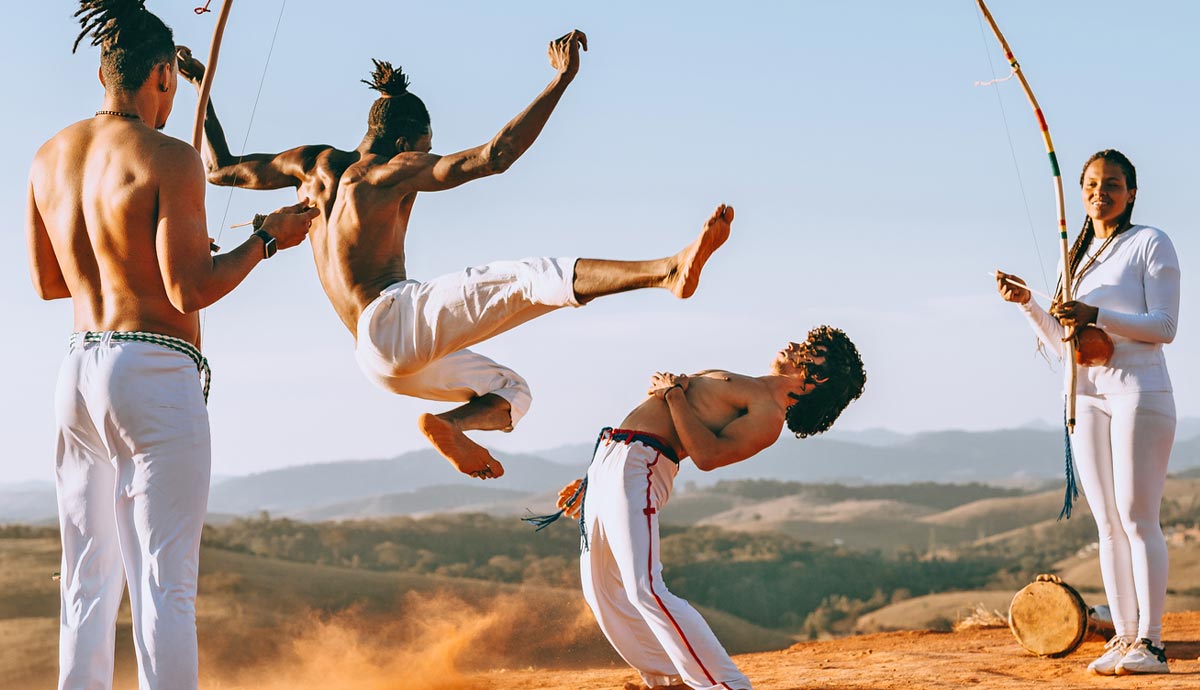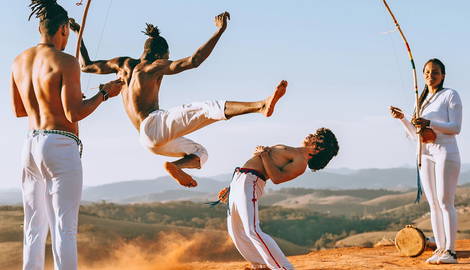
Capoeira is an Afrobrazilian ritual consisting of an improvised dance-fight between two individuals surrounded by a group of people who are singing and playing instruments. People often describe capoeira as a dance, a fight, or a game, but what makes this artistic modality so amazing is that it is all three wrapped in one. You are dancing and playing and fighting—all at the same time.
Capoeira’s Roots: Art of Resistance

Capoeira brings together influences from all over Africa, South America, and Europe. However, this intercultural mix of modalities did not come about by coincidence. In fact, this unique martial art was forged through pain and oppression.
The history of capoeira is deeply connected to the slave trade and the displacement of people that went along with it. When the African slaves were forcibly shipped across the Atlantic, they naturally brought many of their cultural traditions with them. This included the rhythms, songs, and rituals of their homelands. As you can probably imagine, the slave owners were not particularly keen on allowing the people to hold on to their cultural practices. Even less so, if the slaves were doing anything that resembled a fight.

Luckily, the Afrobrazilian slaves managed to find a way around this. Instead of openly partaking in fight training, they made their movements look as dancelike as possible and even accompanied them with music. By hiding their fight-moves within a dance, they managed to get away with training.
A Mix of Cultures and Influences

Over time, capoeira started to get mixed together with indigenous South American traditions and the European culture of their slave masters. If you listen to capoeira songs today, you will hear many references to Afrobrazilian deities, but also to the Christian God. The songs also tend to speak of the experience of crossing the ocean on slave ships, the reality of being a slave, and memories of Africa.
The use of storytelling within capoeira music is yet another example of the power of art: By turning their suffering into music, the oppressed slaves were able to remember and process their trauma. It was also a way of passing on their version of the story to future generations. By doing so, they managed to make sure that their voice would not be silenced. It was their way of ensuring that their version of the story would stay in the memory of their children and even find its way to the world at large. And while the colonizers have done their best to obliterate the many wrongdoings they committed from the pages of history, capoeira songs continue to preserve an alternative perspective.
The Rise of Brazil’s Favelas

Brazil was the last country in the world to abolish slavery. Unfortunately, the reality of the freed slaves remained harsh. Due to the continued racism and lack of opportunities, many former slaves ended up living in improvised shacks on the hills around cities like Rio or São Paulo. These improvised living quarters commonly known as favelas exist up to this day. And while there are all kinds of people living in Brazil’s favelas today, the majority of its population ended up there because their ancestors were slaves and didn’t have anywhere else to go.
When the former slaves moved into Brazil’s favelas, they took capoeira with them. Life in the favela came with many difficulties, but capoeira remained a way of keeping both minds and bodies strong. The practice of capoeira also created a sense of community and joy that uplifted people’s souls.
Unfortunately, the abolition of slavery in 1888 did not mean that the people were now free to practice capoeira. Quite to the contrary. Capoeira remained banned and was actively prosecuted by the police until 1930. But despite the risks of being arrested and imprisoned, people continued to practice capoeira and carry its rich heritage forward into the future.
The Continued Battle Against Oppression

Once it finally became legal to practice capoeira, the martial arts started to gather a larger following. And yet, the reality of many of its practitioners remained extremely tough. Capoeira continued to be considered a lower-class art and did not receive much recognition or support from the state. People continued to see it as an art reserved for people from the favelas, and many of the artists who devoted their entire lives to capoeira died poor.
However, the lack of recognition and the continued difficulties only served to fortify this art form. Capoeira stayed alive in the hearts and bodies of the people practicing it. This martial art literally teaches you how to take a foot in the face or fall to the floor and turn it all into a beautiful dance. It teaches you to accept the obstacles and turn them into something joyful and beautiful. Given the harsh inequality many Brazilian people face up to this day, it is hardly surprising that capoeira continued to thrive. As many capoeiristas will tell you, this martial art does not just help you do amazing things with your body. It also keeps your mind strong and gives you the agility to deal with life’s ups and downs in a more elegant way.
From Favelas to the World

Today, most favelas are ruled by drug cartels and their inhabitants often find themselves in the midst of shoot-outs between rivaling gangs. Unfortunately, the police aren’t exactly there to protect the poorest of the poor either. Of course, it wouldn’t be fair to make sweeping generalizations about all policemen. But the Brazilian police has earned itself a reputation for being racist, brutal, and in some cases corrupt. As the recent raid of Rios favelas has shown, innocent people continue to die in police operations in Brazil’s favelas up to this day. It’s why people in favelas tend to be as scared of the police as they are of the local gangs.
Despite the difficulty of the life circumstances faced by many of the artists who have kept capoeira alive, capoeira has made its way out of the favela and into the entire world.
Today, this art form of resistance is present in 152 countries and counts more than 6 million practitioners. As it turns out, people as far as way as Israel, Russia, or Australia have found something in capoeira that they can’t seem to find within their own cultures.
The Power of Capoeira

Samba, carnival, and capoeira seem to be the three things Brazil is best known for around the world. After all, these cultural practices are all firmly rooted in the culture of the slaves.
But what is it that keeps drawing more and more people into the universe of capoeira? What makes capoeira so powerful is that it can’t be defined. Just like life, it is a dance and a game and a fight. It is also an improvisation, a communal act, and a ritual. It inhabits a liminal space that is beyond the graspable, a space that opens up the infinite and helps us go beyond ourselves.

Capoeira is open to people of all faiths, and while even atheists play and enjoy capoeira, it does have a strong spiritual dimension. Anyone who has ever participated in a capoeira ritual will have felt the powerful energy that emerges when you join together in movement and song. Capoeira practitioners call this energy axé. It is an energy that can’t be seen, but it can definitely be felt. Its power does not lie in the practice of dangerous kicks. What makes this art form so dangerous is that it makes you feel your own power. It also helps you feel the united potential of your community and connects you to the world beyond the physical.
Capoeira: An art for the future?

There is still a lot of work to be done when it comes to bringing about a world, where people of different backgrounds have access to equal opportunities. And yet, capoeira shows us, that even the depths of suffering and injustice can give birth to beautiful art. The days of colonialism may officially be over. And yet, there is a growing number of voices arguing that we are in fact entering an era of digital colonialism.
In the view of some thinkers, our world is only set to become more unequal, as big tech platforms like Google and Meta gather more and more power. When we look towards navigating the future of our increasingly digitalized world, the practice of something as simple as capoeira can prove to be an incredibly useful tool—not only because it forces us to get out of our minds and into our bodies. It also reminds us that no matter the circumstances we can always find a little bit of freedom.










